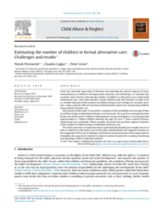Abstract
Given the relatively large body of literature documenting the adverse impacts of institutionalization on children’s developmental outcomes and well-being, it is essential that countries work towards reducing the number of children in alternative care (particularly institutional care), and, when possible, reunite children with their families. In order to do so, reliable estimates of the numbers of children living in such settings are essential. However, many countries still lack functional administrative systems for enumerating children living outside of family care.
The purpose of this paper is to provide a snapshot of the availability and coverage of data on children living in residential and foster care from some 142 countries covering more than 80 per cent of the world’s children. Utilizing these country-level figures, it is estimated that approximately 2.7 million children between the ages of 0 and 17 years could be living in institutional care worldwide.* Where possible, the article also presents regional estimates of the number of children living in residential and foster care.
This work represents an important step to systematically identify and compile sources of data on children in alternative care and provides updated global and regional estimates on the magnitude ofthe issue. Its findings contribute to raising awareness ofthe urgent need to strengthen the capacity of countries to improve national systems for counting, monitoring and reporting on these vulnerable children.
*Since the publishing of this article, a press release has come out stating that the 2.7 million figure is likely a minimum number of children living in institutional care worldwide.

